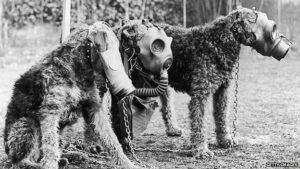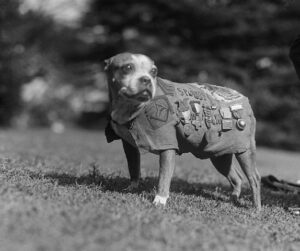Forgotten Friday – It’s A (War) Dogs Life
Eden Camp is a dog friendly attraction and has recently been awarded for its achievement in making dogs and their owners welcome. So to commemorate this we have devoted this Forgotten Friday to the brave ‘Dogs of War’.
Throughout history a dog is referred to as ‘Man’s best friend’ and during times of war this has never been a truer phrase.
Dogs, with their keen sense of smell, could seek out soldiers and civilians in distress or in need of assistance. During both World Wars search and rescue dogs would venture out onto the battlefield to locate and lead stretcher parties to wounded men. They carried water and medical supplies to men out of reach of the ambulances. They were also trained to detect enemy troops, sniff for mines and deliver messages amongst many other roles.

Conditions in the trenches could lead to infestations of disease-spreading pests, particularly rats who were attracted by food, waste and dead bodies. Dogs, especially terriers, were naturals at hunting vermin and were invaluable at keeping them under some sort of control. This helped to protect and help with hygiene in the trenches.
During World War 1 at least 20,000 dogs were recruited into the army and trained to carry out many of these tasks and also some were trained for extra duties like laying telegraph wires, and hauling guns and ammunition.
One notable dog in 1918 was an Airedale Terrier called Jack. Jack saved the lives of the Sherwood Foresters regiment. They had been surrounded by Germans and he was sent with a message requesting immediate help. Under a hail of gunfire he bravely carried on and reached the receiver of the message. The Sherwood Foresters were rescued but unfortunately brave Jack died from his injuries shortly afterwards.
In World War 2 a poster appeared in British newspapers during May 1941 appealing for dogs to be recruited for military purposes. Within two weeks 7,000 dogs had been put forward. The dogs were probably surrendered by their owners due to the shortages of rations and they then had one less mouth to feed. It maybe seemed kinder than having to destroy them.
Dogs also performed search and rescue duties on the home front, helping to detect people trapped under debris following bombing raids by German aircraft. One of the extraordinary dogs was Rip, a stray adopted by Popular ARP (Air Raid Precautions) in East London. During the Blitz he helped locate people and animals buried under debris following an air raid.
Judy, a pointer, became one of the more famous dogs of WW2. She had survived sinking ships, saved countless lives and became a Japanese prisoner of war, lucky to escape with her life. Judy was a ship’s mascot on HMS Gnat and proved her worth by alerting the crew to approaching aircraft and even river pirates. In 1942 she was on HMS Grasshopper when the crew abandoned ship in the South China Sea and she detected fresh water on the island that they had managed to get to. Eventually, the survivors were captured by the Japanese and (Judy included) became prisoners of war. It was here she bonded with the man who was to become her life long companion, Leading Aircraftman Frank Williams. Throughout the time spent under Japanese rule she continued to display her bravery and alertness for the good of the POW’s.
After the war she received the PDSA Dickin Medal and remained with Frank until her death in February 1960 in Tanzania where Frank was working at the time.
Bing, a German Shepherd/Collie cross, was dropped into France by parachute on June 6th 1944 during the D-Day landings. He was one of three paradogs dropped behind enemy lines on this day. Another dog was Bereda, a German Shepherd. The dogs were fitted with parachutes, originally designed to drop bicycles, which opened by a static line as the dogs exited the aircraft.
The PDSA Dickin Medal was introduced in 1943 to honour the work of brave animals.

Washington, DC: Meet up with Stubby, a 9-year-old veteran of the canine species. He has been through the World War as mascot for the 102nd Infantry, 26th Division. Stubby visited the White House to call on President Coolidge. November 1924
Today there is the 1st Military Working Dog Regiment. For Military dogs, who play a pivotal role in search and detection and provide not only vital support to British soldiers but a psychological role too. One of the most recent British Army dogs to receive the Dickin Medal was Sasha, a labrador, who was working in Afghanistan and had located bombs and ammunition before being killed along with her handler in July 2008.
Handlers and dogs develop a close relationship and the authorities aware of this issued a decree in 1942 warning soldiers ‘Don’t make friends with or pet any of these dogs’ however as history has shown us ‘it didn’t work’!!

